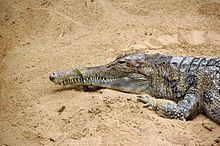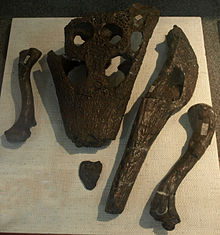- False gharial
-
False gharial Conservation status Scientific classification Kingdom: Animalia Phylum: Chordata Class: Reptilia Order: Crocodilia Family: Crocodylidae[1] Subfamily: Tomistominae Genus: Tomistoma
Müller, 1846Species: T. schlegelii Binomial name Tomistoma schlegelii
Müller, 1838
Range of Tomistoma The false gharial (Tomistoma schlegelii), also known as the Malayan gharial, false gavial, or Tomistoma is a freshwater crocodile of the Crocodylidae family with a very thin and elongated snout. The false gharial is listed as an endangered species by IUCN as the population is estimated at below 2,500 mature individuals.[1]
Contents
Characteristics
Tomistoma skull at the Zoological Museum of the Zoological Institute of the Russian Academy of Sciences, St. Petersburg
The false gharial is a large crocodilian that averages a length of up to 3.5 to 5 m (11 to 16 ft) with an extremely long and slender snout. It is dark reddish-brown above with dark brown or black spots and cross-bands on the back and tail. Ventrals are grayish-white, with some lateral dark mottling. Juveniles are mottled with black on the sides of the jaws, body, and tail. The snout is smooth and unornamented, and 3 to 3.5 times the width at the base. All teeth are long and needle-like, interlocking on the insides of the jaws, and are individually socketed. The fingers are webbed at the base. Integumentary sensory organs are present on the head and body scalation. Scales behind the head are frequently a slightly enlarged single pair. Some individuals bear a number of adjoining small keeled scales. Scalation is divided medially by soft granular skin. Three transverse rows of two enlarged nuchal scales are continuous with the dorsal scales, which consist of 22 transverse rows of 6 to 8 scales, are broad at mid-body and extend onto the sides of the body. Nuchal and dorsal rows equals a total of 22 to 23 rows. It has 18 double crested caudal whorls and 17 single crest caudal whorls. The flanks have one or two longitudinal rows of six to eight very enlarged scales on each side.[2]
Adult males weigh 150 to 250 kg (330 to 550 lb), while females are about 3.2 m (10 ft) long and weigh an average of 90 kg (200 lb).[citation needed]
Distribution and habitat
False gharials are native to Peninsular Malaysia, Sarawak, Sumatra and Borneo, but extirpated in Thailand. In the 1990s, information and sightings were available from 39 localities in 10 different river drainages, along with the remote river systems of Borneo. Apart from rivers, they inhabit swamps and lakes.[1]
Prior to the 1950s, Tomistoma occurred in freshwater ecosystems along the entire length of Sumatra east of the Barisan Mountains. The current distribution in eastern Sumatra has been reduced by 30-40% due to hunting, logging, fires and agriculture.[3]
Ecology and behaviour
Diet
Until recently very little has been known about the diet or behavior of the false gharial within the wild, but thanks to some research on the part of biologists details are slowly being revealed. It has come to the attention of biologists that the false gharial's diet is much more varied than they had originally thought. Until now the false gharial was thought to have a diet similar to its relative the true gharial, i.e. only fish and very small vertebrates, but new evidence and occurrences have proven that the false gharial's broader snout has enabled larger individuals to prey on larger vertebrates including Proboscis monkeys, long-tailed macaques, deer and fruit bats.
At the end of 2008, a ±4 m female false gharial attacked and swallowed a fisherman in central Kalimantan, whose remains were found in the gharial's stomach.[4]
Reproduction
Tomistoma are mound-nesters. Females lay small clutches of 13 to 35 eggs per nest, and appear to produce the largest eggs of extant crocodilians. Sexual maturity in females appears to be attained at around 2.5 to 3 m (8.2 to 9.8 ft), which is large compared to other crocodilians.[3]
It is not known when they breed in the wild or when the nesting season is. Once the eggs are laid, and construction of the mound is completed, the female abandons her nest. Unlike most other crocodilian species, the young receive no parental care and are at risk of being eaten by predators like mongooses, big cats such as tigers and leopards, civets, and wild dogs. The young hatch after 90 days and are left to fend for themselves.
Threats
The false gharial is threatened with extinction throughout most of its range due to the drainage of its freshwater swamplands and clearance of surrounding rainforests. The species is also hunted frequently for its skin and meat, and the eggs are often harvested for human consumption.[4]
Conservation
The false gharial is listed on CITES Appendix I.[1]
Steps have been taken by the Malaysian and Indonesian governments to prevent its extinction in the wild. There are reports of some populations rebounding in Indonesia, yet with this slight recovery, mostly irrational fears of attacks have surfaced amongst the local human population.[4]
Yayasan Ulin (The Ironwood Foundation) is currently attempting to manage a wetland area in East Kalimantan which is known to contain the gharials. [5]
Taxonomy
From a morphological standpoint, it has been originally placed within the family Crocodylidae, but recent immunological studies suggest that it is more closely related to the gharial than was originally thought. Along with close fossil relatives such as Maroccosuchus, it is sometimes classed in the family Gavialidae.[6]
References
- ^ a b c d e "Tomistoma schlegelii". IUCN Red List of Threatened Species. Version 2010.4. International Union for Conservation of Nature. 2000. http://www.iucnredlist.org/apps/redlist/details/21981.
- ^ Brazaitis, P. (2001) A Guide to the Identification of the Living Species of Crocodilians. Science Resource Center, Wildlife Conservation Society
- ^ a b Bezuijen, M.R., Webb, G.J.W., Hartoyo, P., Samedi, Ramono, W.S., Manolis, S.C. (1998) The False Gharial (Tomistoma schlegelii) in Sumatra. In: Crocodiles. Proceedings of the 14th Working Meeting of the Crocodile Specialist Group, IUCN. The World Conservation Union, Gland, Switzerland and Cambridge, UK. Pp. 10–31.
- ^ a b c Rachmawan, D., Brend, S. (2009) Human-Tomistoma interactions in central Kalimantan, Indonesian Borneo Crocodile Specialist Group Newsletter January 2009 – March 2009. Volume 28 No. 1: 9–11.
- ^ http://www.speciesconservation.org/projects/Siamese-Crocodile/309
- ^ "Molecular Systematics of the Order Crocodilia". http://icb.oxfordjournals.org/cgi/content/abstract/29/3/831.
External links
- Crocodile Specialist Group: Tomistoma schlegelii
- Tomistoma Task Force
- Saint Louis Zoo: False Gharial
- ARKive Images
- BBC News: 'Match-making' for rare male croc
- Tomistoma schlegelii - Description with photographs from captivity in Czech republic (in Czech)
- The Orangutan Foundation research centre being used for critical research on False gharial
Extant Crocodilian species Kingdom: Animalia · Phylum: Chordata · Class: Sauropsida · (unranked): Archosauria · Superorder: CrocodylomorphaFamily Gavialidae TomistomaFalse gharial (T. schlegelii)Family Alligatoridae Alligatorinae
(Alligators)Caimaninae
(Caimans)Related articles on alligators, caimans, crocodiles and gharials Topics Human
interactionU.S. Alligator fatalities · Crocodile attacks · Alligator farm · Crocodile tears · Famous crocodiles and alligators · Sewer alligatorCategories:- IUCN Red List endangered species
- Crocodilians
- Gavialidae
- Reptiles of Malaysia
- Reptiles of Indonesia
- Fauna of Borneo
Wikimedia Foundation. 2010.





